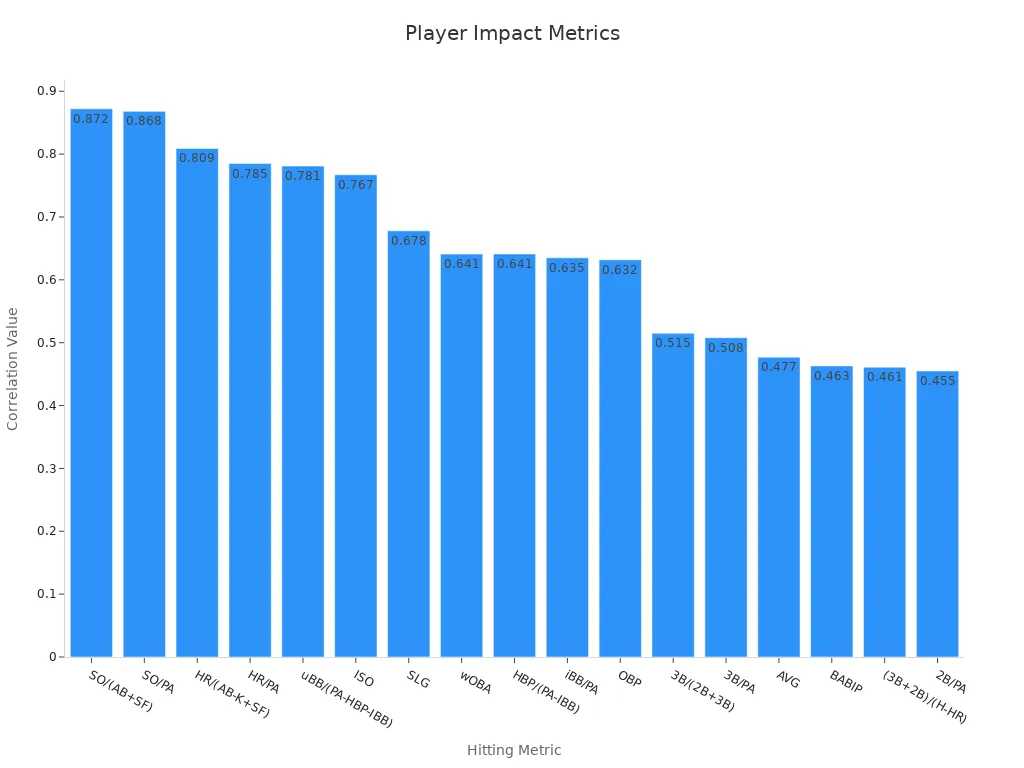
In baseball, “AB” stands for “At Bats” and plays a crucial role in the game. AB in baseball refers to the number of times a player attempts to hit during a game, excluding walks or sacrifices. It is essential for calculating stats like batting average, which is determined by dividing hits by at bats. Additionally, AB in baseball is used to calculate at bats per home run, providing insight into a player’s ability to hit home runs effectively.
Key Takeaways
AB means At Bats. It shows how often a player tries to hit the ball. Walks and sacrifices are not included. AB is important for finding stats like batting average.
Not every time at the plate counts as AB. Walks, getting hit by a pitch, or sacrifices don’t count. This keeps stats fair and correct.
AB links to stats like batting average and on-base percentage. These stats together show how well a player performs overall.
What Counts as AB in Baseball?

Definition of At Bat
An “At Bat” (AB) happens when a batter takes their turn. It is recorded if the batter hits, strikes out, or gets out another way. Some situations do not count as an at bat, which will be explained later.
Here are two important rules from baseball’s rulebook:
Rule Number | Description |
|---|---|
9.02(a)(1) | Lists exceptions like walks, sacrifice bunts, being hit by a pitch, or interference. |
5.06(c) | Says a batter finishes their turn when they are out or become a runner. |
These rules make sure at bats are counted the same way in all games. They also help calculate stats like batting average, which depends on correct at bat numbers.
What Does Not Count as an At Bat?
Not all plate appearances are considered at bats. Some situations are excluded because they don’t involve trying to hit the ball. For example, walks or being hit by a pitch do not count as at bats. Sacrifice bunts or flies, which help runners advance, are also excluded.
Here are more examples of when a plate appearance does not count as an at bat:
Scenario Description | Reason for Not Counting as At Bat |
|---|---|
A batter reaches first base due to a dropped foul fly. | The error extends the time at bat. |
A batter reaches base because of interference or obstruction. | The play is affected by outside factors. |
A runner stays on base longer because of an error. | Without the error, the runner would have been out. |
A scoring runner advances due to an error, passed ball, or interference. | The run depends on a mistake or misplay. |
These exceptions keep stats fair and accurate. They also show how a batter’s actions differ from outside events that affect the game.
AB in Baseball and Its Link to Other Stats
AB and Batting Average (AVG)
Batting Average (AVG) is a key baseball stat. It shows how often a player gets a hit. To find AVG, divide hits by at bats. For example, 50 hits in 200 at bats equals a .250 average. This means the player gets a hit 25% of the time.
AB helps us understand how good a player is at hitting. But AVG alone doesn’t tell everything. Other stats like on-base percentage (OBP) and slugging percentage (SLG) add more details. These stats show how well a player helps their team score runs.
Studies show OBP predicts scoring better than AVG.
History shows batting averages change over time. Strikeout average (KAVG) and in-play average (IPAVG) are also important.
Looking at these stats together gives a clearer picture. AB connects directly to AVG, but combining stats shows a player’s full impact.
AB and Plate Appearances (PA)
Plate Appearances (PA) count every time a player bats. Not all PA are AB. Walks, sacrifices, and being hit by a pitch don’t count as AB. PA gives a bigger view of a player’s chances, while AB focuses on results.
Baseball formulas show how AB and PA are related:
Formula | What It Shows |
|---|---|
PA = AB + W | |
PA = K + (3*IP – K)*x + H + W | PA uses strikeouts, innings pitched, hits, and walks. |
%H = (H – HR)/(PA – HR – K – W) | Batting average on balls in play comes from PA. |
These formulas link AB to PA and other stats. On-Base Percentage (OBP) uses PA to show how often a player gets on base. Slugging Percentage (SLUG) uses AB to measure bases per at bat. Both stats depend on AB and PA.
Knowing how AB and PA connect helps you judge a player’s skill. AB focuses on results, while PA shows overall chances. Together, they build the base for advanced baseball stats.
The Role of AB in Player Performance

How AB Shows Player Skills
AB tells how often a player bats in a game. It shows chances to hit and help the team score. Stats like strikeouts per at bat (SO/AB) and home runs per at bat (HR/AB) explain player strengths. A high HR/AB means the player hits home runs often. A low SO/AB shows the player avoids striking out and makes good contact.
The table below shows how AB connects to hitting stats:
Hitting Stat | |
|---|---|
SO/(AB+SF) | 0.872 |
HR/(AB-K+SF) | 0.809 |
SLG | 0.678 |
AVG | 0.477 |
These numbers prove AB helps measure hitting skills. But adding stats like slugging percentage (SLG) or batting average (AVG) gives a clearer view of a player’s hitting ability.

AB Has Limits as a Single Stat
AB is useful but doesn’t show everything about a player. It skips walks, sacrifices, and hit-by-pitches, which also help the team. A player with high on-base percentage (OBP) might be great at reaching base without many at bats.
Studies show AB alone misses key details. Like basketball players who play different roles, baseball players contribute in unique ways. Advanced stats like expected batting average (xBA) and expected weighted on-base average (xwOBA) give better insights:
Stat | What It Measures | |
|---|---|---|
xBA | Predicted Batting Average | 0.799 |
xwOBA | Predicted Weighted On-Base Average | 0.843 |
Using AB with modern stats helps you see a player’s full value in the game.
Knowing “AB” helps you understand a player’s hitting skills. It shows how often a batter helps their team score. Learn more by studying stats like plate appearances and batting average. Slugging percentage also gives insight into a player’s game impact. These stats together show a player’s overall contribution.
FAQ
What is the difference between AB and PA in baseball?
AB means “At Bats” and skips walks or sacrifices. PA, or “Plate Appearances,” counts every time you bat, including these.
Why don’t sacrifices count as an at bat?
Sacrifices move runners forward instead of showing hitting skill. Leaving them out makes batting stats fair and correct.
How does AB affect a player’s batting average?
Batting average uses AB to measure hitting success. Divide hits by AB to find how often you hit the ball.
